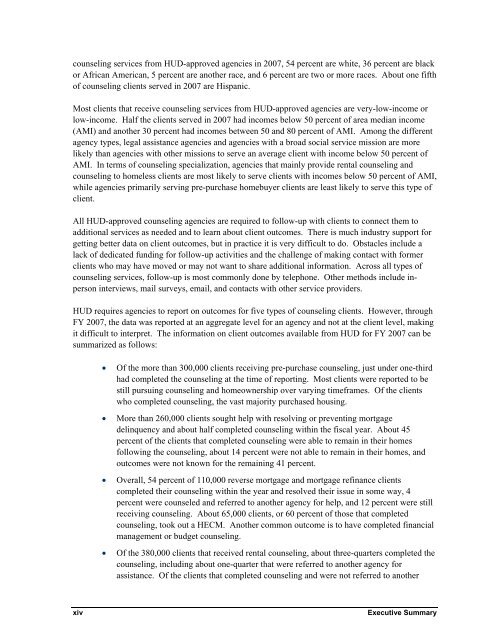Housing Counseling Process Evaluation and Design of ... - HUD User
Housing Counseling Process Evaluation and Design of ... - HUD User
Housing Counseling Process Evaluation and Design of ... - HUD User
Create successful ePaper yourself
Turn your PDF publications into a flip-book with our unique Google optimized e-Paper software.
counseling services from <strong>HUD</strong>-approved agencies in 2007, 54 percent are white, 36 percent are black<br />
or African American, 5 percent are another race, <strong>and</strong> 6 percent are two or more races. About one fifth<br />
<strong>of</strong> counseling clients served in 2007 are Hispanic.<br />
Most clients that receive counseling services from <strong>HUD</strong>-approved agencies are very-low-income or<br />
low-income. Half the clients served in 2007 had incomes below 50 percent <strong>of</strong> area median income<br />
(AMI) <strong>and</strong> another 30 percent had incomes between 50 <strong>and</strong> 80 percent <strong>of</strong> AMI. Among the different<br />
agency types, legal assistance agencies <strong>and</strong> agencies with a broad social service mission are more<br />
likely than agencies with other missions to serve an average client with income below 50 percent <strong>of</strong><br />
AMI. In terms <strong>of</strong> counseling specialization, agencies that mainly provide rental counseling <strong>and</strong><br />
counseling to homeless clients are most likely to serve clients with incomes below 50 percent <strong>of</strong> AMI,<br />
while agencies primarily serving pre-purchase homebuyer clients are least likely to serve this type <strong>of</strong><br />
client.<br />
All <strong>HUD</strong>-approved counseling agencies are required to follow-up with clients to connect them to<br />
additional services as needed <strong>and</strong> to learn about client outcomes. There is much industry support for<br />
getting better data on client outcomes, but in practice it is very difficult to do. Obstacles include a<br />
lack <strong>of</strong> dedicated funding for follow-up activities <strong>and</strong> the challenge <strong>of</strong> making contact with former<br />
clients who may have moved or may not want to share additional information. Across all types <strong>of</strong><br />
counseling services, follow-up is most commonly done by telephone. Other methods include inperson<br />
interviews, mail surveys, email, <strong>and</strong> contacts with other service providers.<br />
<strong>HUD</strong> requires agencies to report on outcomes for five types <strong>of</strong> counseling clients. However, through<br />
FY 2007, the data was reported at an aggregate level for an agency <strong>and</strong> not at the client level, making<br />
it difficult to interpret. The information on client outcomes available from <strong>HUD</strong> for FY 2007 can be<br />
summarized as follows:<br />
• Of the more than 300,000 clients receiving pre-purchase counseling, just under one-third<br />
had completed the counseling at the time <strong>of</strong> reporting. Most clients were reported to be<br />
still pursuing counseling <strong>and</strong> homeownership over varying timeframes. Of the clients<br />
who completed counseling, the vast majority purchased housing.<br />
• More than 260,000 clients sought help with resolving or preventing mortgage<br />
delinquency <strong>and</strong> about half completed counseling within the fiscal year. About 45<br />
percent <strong>of</strong> the clients that completed counseling were able to remain in their homes<br />
following the counseling, about 14 percent were not able to remain in their homes, <strong>and</strong><br />
outcomes were not known for the remaining 41 percent.<br />
• Overall, 54 percent <strong>of</strong> 110,000 reverse mortgage <strong>and</strong> mortgage refinance clients<br />
completed their counseling within the year <strong>and</strong> resolved their issue in some way, 4<br />
percent were counseled <strong>and</strong> referred to another agency for help, <strong>and</strong> 12 percent were still<br />
receiving counseling. About 65,000 clients, or 60 percent <strong>of</strong> those that completed<br />
counseling, took out a HECM. Another common outcome is to have completed financial<br />
management or budget counseling.<br />
• Of the 380,000 clients that received rental counseling, about three-quarters completed the<br />
counseling, including about one-quarter that were referred to another agency for<br />
assistance. Of the clients that completed counseling <strong>and</strong> were not referred to another<br />
xiv<br />
Executive Summary
















